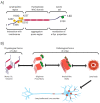Alpha-Synuclein in the Gastrointestinal Tract as a Potential Biomarker for Early Detection of Parkinson's Disease
- PMID: 33212934
- PMCID: PMC7698349
- DOI: 10.3390/ijms21228666
Alpha-Synuclein in the Gastrointestinal Tract as a Potential Biomarker for Early Detection of Parkinson's Disease
Abstract
The primary pathogenesis associated with Parkinson's disease (PD) occurs in peripheral tissues several years before the onset of typical motor symptoms. Early and reliable diagnosis of PD could provide new treatment options for PD patients and improve their quality of life. At present, however, diagnosis relies mainly on clinical symptoms, and definitive diagnosis is still based on postmortem pathological confirmation of dopaminergic neuronal degeneration. In addition, the similarity of the clinical, cognitive, and neuropathological features of PD with other neurodegenerative diseases calls for new biomarkers, suitable for differential diagnosis. Alpha-synuclein (α-Syn) is a potential PD biomarker, due to its close connection with the pathogenesis of the disease. Here we summarize the currently available information on the possible use of α-Syn as a biomarker of early stages of PD in gastrointestinal (GI) tissues, highlight its potential to distinguish PD and other neurodegenerative diseases, and suggest alternative methods (primarily developed for other tissue analysis) that could improve α-Syn detection procedures or diagnostic methods in general.
Keywords: LCO; PMCA; Parkinson’s disease; alpha-synuclein; biomarker; gastrointestinal tract; microRNA; oligomeric alpha-synuclein.
Conflict of interest statement
The authors declare no conflict of interest.
Figures



Similar articles
-
Alpha-Synuclein in Peripheral Tissues in Parkinson's Disease.ACS Chem Neurosci. 2019 Feb 20;10(2):812-823. doi: 10.1021/acschemneuro.8b00383. Epub 2019 Feb 11. ACS Chem Neurosci. 2019. PMID: 30714719 Review.
-
Gastrointestinal nervous system α-synuclein as a potential biomarker of Parkinson disease.Medicine (Baltimore). 2018 Jul;97(28):e11337. doi: 10.1097/MD.0000000000011337. Medicine (Baltimore). 2018. PMID: 29995769 Free PMC article.
-
Salivary alpha-synuclein as a biomarker for Parkinson's disease: a systematic review.J Neural Transm (Vienna). 2019 Nov;126(11):1373-1382. doi: 10.1007/s00702-019-02062-4. Epub 2019 Aug 10. J Neural Transm (Vienna). 2019. PMID: 31401695
-
Nitrated alpha-synuclein in minor salivary gland biopsies in Parkinson's disease.Neurosci Lett. 2019 Jun 21;704:45-49. doi: 10.1016/j.neulet.2019.03.054. Epub 2019 Apr 1. Neurosci Lett. 2019. PMID: 30946930
-
No enhanced (p-) α-synuclein deposition in gastrointestinal tissue of Parkinson's disease patients.Parkinsonism Relat Disord. 2020 Nov;80:82-88. doi: 10.1016/j.parkreldis.2020.08.020. Epub 2020 Aug 18. Parkinsonism Relat Disord. 2020. PMID: 32971383
Cited by
-
The Relationship Between Autonomic Dysfunction and Mood Symptoms in De Novo Parkinson's Disease Patients Over Time.J Geriatr Psychiatry Neurol. 2024 May;37(3):242-252. doi: 10.1177/08919887231204542. Epub 2023 Oct 13. J Geriatr Psychiatry Neurol. 2024. PMID: 37831611 Free PMC article.
-
A simple-to-use web-based calculator for survival prediction in Parkinson's disease.Aging (Albany NY). 2021 Feb 1;13(4):5238-5249. doi: 10.18632/aging.202443. Epub 2021 Feb 1. Aging (Albany NY). 2021. PMID: 33535176 Free PMC article.
-
The Potentiality of Natural Products and Herbal Medicine as Novel Medications for Parkinson's Disease: A Promising Therapeutic Approach.Int J Mol Sci. 2024 Jan 15;25(2):1071. doi: 10.3390/ijms25021071. Int J Mol Sci. 2024. PMID: 38256144 Free PMC article. Review.
-
Immunological Features of LRRK2 Function and Its Role in the Gut-Brain Axis Governing Parkinson's Disease.J Parkinsons Dis. 2023;13(3):279-296. doi: 10.3233/JPD-230021. J Parkinsons Dis. 2023. PMID: 37066923 Free PMC article. Review.
-
Parkinson disease therapy: current strategies and future research priorities.Nat Rev Neurol. 2024 Dec;20(12):695-707. doi: 10.1038/s41582-024-01034-x. Epub 2024 Nov 4. Nat Rev Neurol. 2024. PMID: 39496848 Review.
References
Publication types
MeSH terms
Substances
Grants and funding
LinkOut - more resources
Full Text Sources
Medical
Miscellaneous

